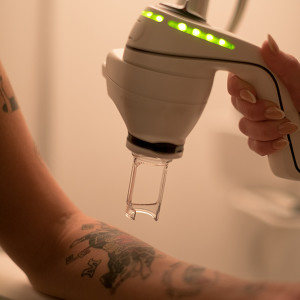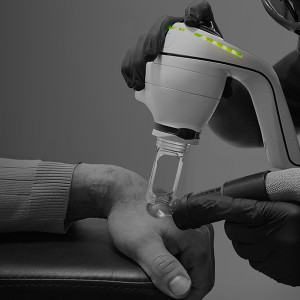Pico laser tattoo removal explained
The LightSense™ laser is a type of picosecond laser. A very fine one at that.
In picosecond laser tattoo removal, the duration of the laser’s pulse is measured in picoseconds (one trillionth of a second).
After explaining that the name refers to a measurement of time, the other thing you need to know from us is that our Central London Studio is the only place you’ll find the LightSense™ laser, where our experts are specially trained to use it.
To explain picosecond laser tattoo removal and the different technologies on offer, we’ll look first at some of the terminology around the lasers, and then at what the LightSense™ laser does particularly well.
PICOSECONDS TO SECONDS
Split seconds
The internationally agreed system of SI units (International System of Units) was adopted by scientists in the 1960s. And as technology develops, new prefixes are added: nano, pico, femto, atto, zepto, yocto.
What is picosecond laser tattoo removal?
Pico refers specifically to the duration of the laser’s pulse. That is, how long the pulse or flash of light is on for. A picosecond is a measurement of time. It is one trillionth of a second. Its less obscure relative, the nanosecond, is one thousand-millionth of a second. In case these minuscule numbers are difficult to visualise, above is a helpful chart.
THE LIGHTSENSE™ LASER
Why are picosecond lasers used for tattoo removal?
When targeted accurately, the ink pigment that sits in the dermis of the skin becomes heated by the pulses of light, which in turn causes them to break apart so they can be flushed out by the body’s natural immune system.
THE MORE COMPLEX ANSWER
When you get a tattoo, the immune system’s response to the newly injected ink is to get out its heavies, the macrophages, which essentially engulf the ink in a process called phagocytosis.
It’s the bodily equivalent of the on-screen bar brawl, holding the ink back and yelling: “stop it, they’re not worth it.”
Because the macrophages cannot fight off the attack on the immune system, they contain it.
When the laser breaks the ink down into smaller parts, the macrophages step in again and help to flush it out.
We cannot overstate the importance of a healthy immune system for getting the best results out of laser tattoo removal: the healthier you are the easier it is for your body to flush out these particles of ink.
THE LIGHTSENSE™ LASER
11 times more precise than the average Pico laser
Spot size and repetition rate
The LightSense™ laser is 11 times more precise than the average Pico laser. The ultra-precise spot size comes in at a minuscule 0.4mm, smaller than the nib of a pen. This allows experts to use ultra-low energy and cause far less pain, because of the concept of fluence (we’ll get to this in a moment).
Repetition rate is simply how many times a second the laser can fire. The LightSense™ laser has been specially developed to have an extremely high repetition rate, meaning it can cover more skin, faster.
Fluence
We’ve mentioned the ultra-precise spot size coming in at a pinpoint 0.4mm. This allows our experts to operate on ultra-low energy and so cause much less pain, because of the concept of fluence.
Fluence measures the energy delivered per area. Commonly, it is measured in joules per square centimetre (J/cm2) – it is how concentrated the laser beam is.
Think of a garden hose. When you want the stream to become more powerful you cover some of the nozzle with your thumb. The same principle applies here.
The precision of the laser (a smaller area like the partially covered hose) means our experts direct lower energy onto the skin.
Pulse width
The pulse width, essentially how long the laser pulse is on the skin, is 89 times shorter than the average Pico laser. Your skin is exposed for far less time than with other lasers.
It works a bit like ripping off a plaster, if you do it quickly you feel less pain.
Using low energy (specifically, 34 times less than the average Pico laser) means that our experts can treat clients every two to three weeks, as opposed to six to eight with other lasers.
With more frequent sessions you get tattoo removal in months not years.
Where is all of this happening in the skin?
When a tattoo artist injects ink into your skin it is deposited in your dermis, the middle layer that sits between the epidermis and hypodermis.
That’s where the aforementioned macrophages engulf it, keeping it lodged there until a laser dislodges it.
A GLOSSARY OF TERMS
Picosecond laser – the duration of the laser’s pulse is measured in picoseconds (one trillionth of a second)
The pulse width - how long the laser pulse touches the skin
Repetition rate - how many times a second the laser can fire
Fluence - measures the energy delivered per area
Overload – the feeling laser technology often inspires in people
We hope that this guide to picosecond laser tattoo removal has outlined the terminology associated with the LightSense™ laser, as well as why it offers fast, effective, and near pain-free clearing.
The LightSense™ laser is a type of picosecond laser that, as we have shown, has numerous advantages. It is only available in our Central London Studio.
Read more about these advantages here or about NAAMA’s studio, where you’ll find the technology, here.









